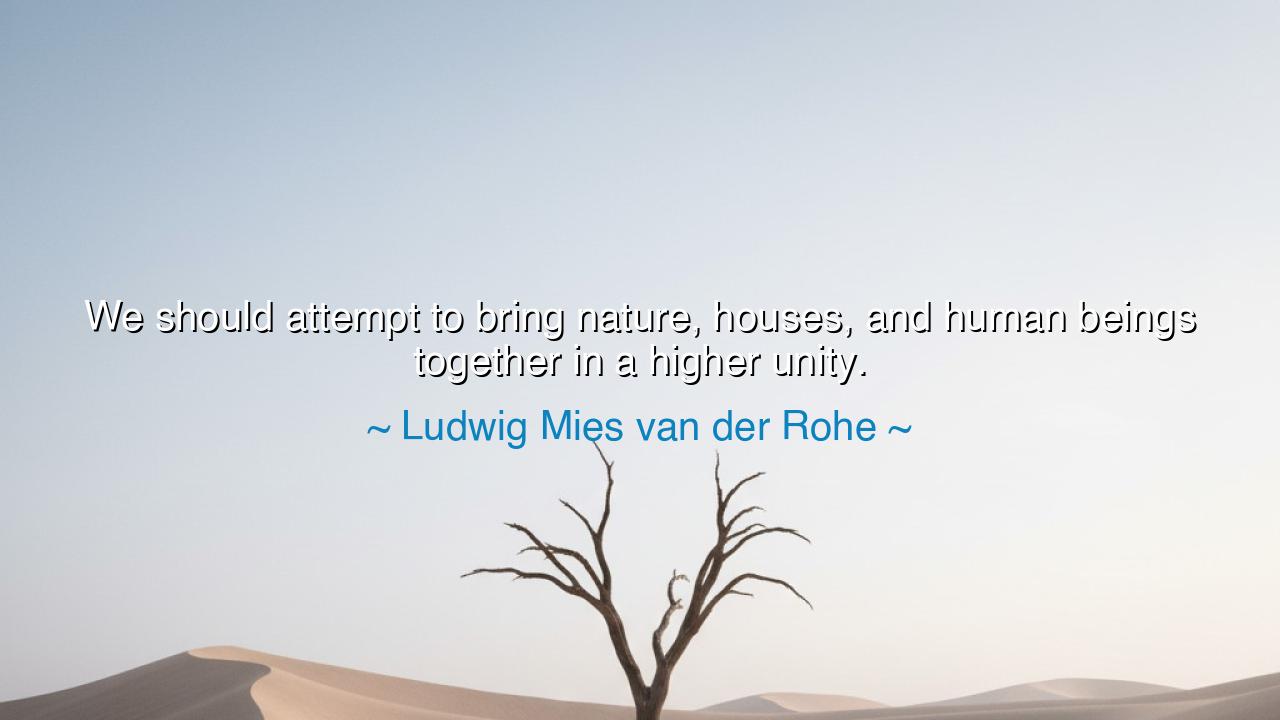
We should attempt to bring nature, houses, and human beings
We should attempt to bring nature, houses, and human beings together in a higher unity.






Ludwig Mies van der Rohe, master of modern architecture, proclaimed: “We should attempt to bring nature, houses, and human beings together in a higher unity.” In this utterance lies not merely an instruction to builders, but a sacred philosophy of living. It speaks of the harmony that must exist between the earth that sustains us, the shelters we construct, and the souls that dwell within them. He who separates these realms—tearing man from nature, or nature from dwelling—sows only discord. But he who unites them raises life itself into beauty, peace, and order.
The origin of this quote rests in Mies’s vision of architecture as more than stone and glass. He lived in an age when cities stretched upward in steel and concrete, when mankind sought to dominate nature rather than dwell with it. Against this, Mies declared that architecture must not be a fortress against the world, but a bridge into it. He believed that the home should not cage man from sunlight or air, but invite them in, letting the dwelling breathe with the rhythms of the earth. His call was for a higher unity, a union in which the natural, the built, and the human existed not as enemies but as companions.
This vision is echoed in the wisdom of the ancients. Consider the temples of ancient Greece, built with open colonnades that allowed wind and light to dance among the worshippers. The Parthenon was not a sealed tomb of stone, but a space where heaven and earth could meet. Or remember the gardens of ancient China, where houses were arranged with flowing streams, stones, and plants to mirror the balance of heaven. These civilizations understood what Mies reclaimed: that true architecture is not against nature, but with it.
The meaning is profound. To separate man from nature is to wound both. For when houses stand as walls of exile, the spirit withers. When nature is stripped away for lifeless dwellings, the earth groans. But when the three are woven together, human beings flourish, their homes breathe with light and air, and nature itself is honored, not destroyed. Such unity elevates life from survival to sanctity.
Think also of a more recent example: Frank Lloyd Wright, who designed Fallingwater in Pennsylvania. This house does not sit upon the land as a conqueror, but springs from it, perched above a waterfall, merging stone, water, wood, and air into a single vision. Visitors who stand within it feel not imprisoned by walls but expanded by them, as if the house itself is an extension of the forest. Such is the living embodiment of Mies’s teaching: that the dwelling can be the bond between man and earth, not the barrier.
From this we learn a lesson for our own lives. When you build, when you dwell, when you choose the spaces you call home, seek harmony with nature. Open windows to the light. Allow gardens and trees to embrace your walls. Use what the land offers, not to dominate it, but to complement it. Even in the city, plant small flowers upon your balcony, or let fresh air breathe into your rooms. By these small acts, you restore to yourself the unity Mies envisioned.
Thus, the wisdom is clear: architecture is not merely about houses—it is about life itself. It is the art of weaving human spirit into the fabric of the world. To live well is not to build higher walls, but to live in communion with the sky above, the soil beneath, and the dwelling around us. Let us, then, follow Mies’s teaching: to strive always for that higher unity, where man, house, and nature exist as one harmonious whole. For in that union lies not only beauty, but truth.






AAdministratorAdministrator
Welcome, honored guests. Please leave a comment, we will respond soon